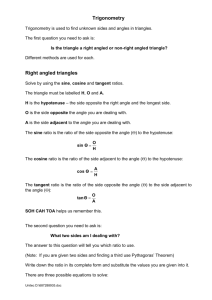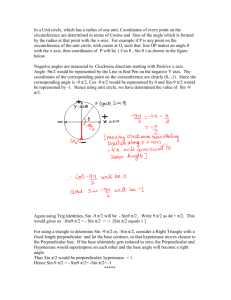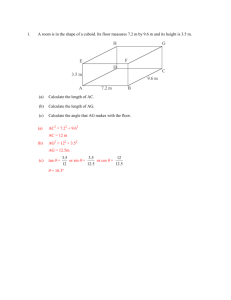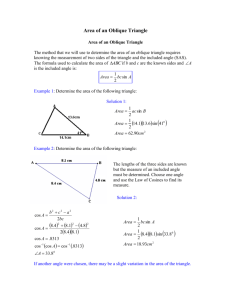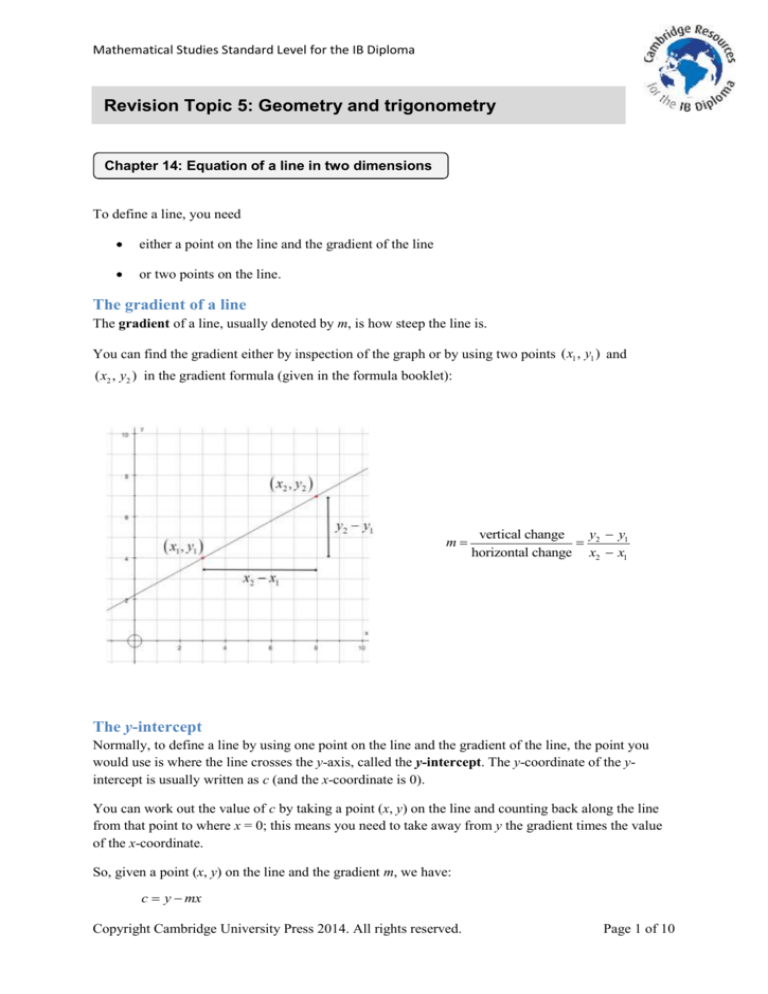
Mathematical Studies Standard Level for the IB Diploma
Revision Topic 5: Geometry and trigonometry
Chapter 14: Equation of a line in two dimensions
To define a line, you need
either a point on the line and the gradient of the line
or two points on the line.
The gradient of a line
The gradient of a line, usually denoted by m, is how steep the line is.
You can find the gradient either by inspection of the graph or by using two points ( x1 , y1 ) and
( x2 , y2 ) in the gradient formula (given in the formula booklet):
m
y y1
vertical change
2
horizontal change x2 x1
The y-intercept
Normally, to define a line by using one point on the line and the gradient of the line, the point you
would use is where the line crosses the y-axis, called the y-intercept. The y-coordinate of the yintercept is usually written as c (and the x-coordinate is 0).
You can work out the value of c by taking a point (x, y) on the line and counting back along the line
from that point to where x = 0; this means you need to take away from y the gradient times the value
of the x-coordinate.
So, given a point (x, y) on the line and the gradient m, we have:
c y mx
Copyright Cambridge University Press 2014. All rights reserved.
Page 1 of 10
Mathematical Studies Standard Level for the IB Diploma
The equation of a straight line
The equation of a straight line is normally given in one of two ways:
y mx c
ax by d 0
In questions, you are more likely to start with y mx c
and then rearrange it to ax by d 0
The ‘general’ form, ax + by + d = 0
Given two points ( x1 , y1 ) and ( x2 , y2 ) on the line and the y-intercept coordinate c, you can choose the
values of a, b and d as follows:
a y1 y2
b x2 x1
d c( x1 x2 )
If you are given an equation in the form ax by d 0 , you can find the gradient m and y-intercept c
as follows:
m
a
b
c
d
b
Drawing a straight line graph from an equation
The easiest way to do this is to plot two points whose coordinates satisfy the equation and draw a
straight line through them.
The quickest way to find two points depends on the form of equation you have:
y mx c
ax by d 0
First point
(0, c)
Set x = 0 to get y
d
; then plot the
b
point (0, bd )
Second point
Pick a value for x. Then work out the
corresponding value for y using the
equation.
d
Set y = 0 to get x
; then plot the
a
point ( ad , 0)
Parallel and perpendicular lines
Parallel and perpendicular lines are related as follows:
Relation between the lines
Parallel
Relation between the gradients
They are the same
Formally written as
m1 m2
Perpendicular
Multiplying them will give the value of −1
m1 m2 1
Copyright Cambridge University Press 2014. All rights reserved.
Page 2 of 10
Mathematical Studies Standard Level for the IB Diploma
Chapter 15: Trigonometry
You are expected to know Pythagoras’ theorem and be able to use it to find missing sides as follows:
Finding the hypotenuse: c a 2 b 2
Finding a side if you know the hypotenuse: a c 2 b 2
Trigonometric ratios
The ratios between the sides of a right-angled triangle don’t change as long as the angles stay the
same. Thus, these ratios are saved on your GDC in the functions sine, cosine and tangent, or sin, cos
and tan for short.
For a right-angled triangle with one other angle given, the sides are denoted as follows:
O Opposite the given angle
A Between the given angle and the right angle
H Opposite the right angle
The standard way of writing the ratios is:
sin
O
,
H
cos
A
,
H
tan
O
A
Depending on what information you are given in the question and what you need to work out, you
will use one of these three methods:
You are asked about
Finding a side using ×
Finding a side using ÷
O and H
O H sin
H O sin
A and H
A H cos
H A cos
O and A
O A tan
A O tan
Copyright Cambridge University Press 2014. All rights reserved.
Finding an angle
O
sin 1
H
A
cos 1
H
O
tan 1
A
Page 3 of 10
Mathematical Studies Standard Level for the IB Diploma
Angles of elevation and depression
These are both measurements from a horizontal line known as ‘eye level’.
Elevation is the angle going up, and depression is the angle going down.
The sine rule, cosine rule, and area of a triangle
To work out lengths or angles in triangles
without a right angle, you can’t use the same
method as above. In this situation, each side of
the triangle is paired with the angle opposite it,
as shown in the diagram.
Cosine rule
a
b
c
sin A sin B sin C
a2 b2 c2 2bc cos A
Area of a triangle
Area ab sin C
Sine rule
There are three formulas you can use,
depending on what you want to work
out and what information you have.
1
2
In each case, put the values you know into the appropriate formula and then work out the missing
value on your GDC. Here, a ‘pair’ means an angle and the opposite side.
What you know
What you want
to work out
A pair,
say a and A
Missing side,
say b
A pair
say a and A
Three pieces of
information but
not a pair
Three pieces of
information but
not a pair
Two sides and
the angle between
them
You will need to use this
rule
Sine rule
a
b
c
sin A sin B sin C
You will need to do this
calculation on your GDC
Missing angle,
say C
Inverted sine rule
sin A sin B sin C
a
b
c
sin C c
Missing side,
say a
Cosine rule
a2 b2 c2 2bc cos A
a b2 c2 2bc cos A
Missing angle,
say A
Rearranged cosine rule
b2 c 2 a 2
cos A
2bc
b2 c 2 a 2
A cos1
2bc
The area of the
triangle
Area ab sin C
1
2
Copyright Cambridge University Press 2014. All rights reserved.
b
a
sin B
sin A
sin A
and then
a
sin A
C sin 1 c
a
1
Area ab sin C
2
Page 4 of 10
Mathematical Studies Standard Level for the IB Diploma
When solving problems involving trigonometry, remember that:
You will probably need to draw a diagram by interpreting the text in the question.
You may need to use angles measured from a specific direction, such as ‘North’.
If you don’t have the correct information for calculating the area of a triangle, work out the
side or angle you need first.
Copyright Cambridge University Press 2014. All rights reserved.
Page 5 of 10
Mathematical Studies Standard Level for the IB Diploma
Chapter 16: Geometry of three-dimensional solids
When calculating with three-dimensional solids in the exam, you will only need to use rightangled trigonometry.
On your GDC, you should use the button for calculations.
You need to know the following vocabulary:
A corner of the shape; often referring specifically to the top corner of a pyramid or cone
Vertex
Midpoint The point half-way along an edge
A flat two-dimensional space, like a piece of paper
Plane
Copyright Cambridge University Press 2014. All rights reserved.
Page 6 of 10
Mathematical Studies Standard Level for the IB Diploma
Finding the length of a line within a three-dimensional solid
Within the solids you will be working with, there are right-angled corners. You need to find these and
use them to create right-angled triangles so that you can work out missing lengths.
The situations you are likely to encounter most often include these right-angles:
The length you
want to work out
Height of a
triangular face
Construct the right-angle
by doing the following
Drop a vertical line down
from the vertex (top corner)
to the centre of the base; then
join the centre of the base to
the midpoint of an edge of
the base.
Pyramid
Length of a
diagonal edge
from the base to
the vertex
Drop a vertical line down
from the vertex to the centre
of the base; then join the
centre of the base to a corner
of the base.
Cuboid
Length of the
diagonal across
one rectangular
face
Draw from the ends of the
diagonal to either of the
untouched corners of the
rectangle.
Cuboid
Length of threedimensional
diagonal across
the box
From one end, draw along
the edge of the box to the
next corner. From the other
end, go diagonally across the
appropriate face to meet the
first line.
Cone
Slant height of the Drop a vertical line down
cone
from the vertex to the centre
of the base; then join the
centre of the base to the
curved edge of the base.
Solid
Pyramid
Image of the construction
To work out a length in a three-dimensional solid, you need to do the following:
Draw the length you need to find as one side of a right-angled triangle as shown above.
Use trigonometry or Pythagoras’ theorem to calculate the length.
Copyright Cambridge University Press 2014. All rights reserved.
Page 7 of 10
Mathematical Studies Standard Level for the IB Diploma
Finding the size of an angle in a three-dimensional solid
Use the same triangles as for finding lengths in three-dimensional solids, but in this case you will also
need to use trigonometry to calculate the missing angle.
It is important to make sure you are finding the correct angle, so read the question very carefully.
When an angle is labelled using three letters, it is
a good idea to draw the angle with the letters.
ˆ in this
For example, to draw angle ABC
diagram, you go from the vertex A down along
an edge to vertex B and then into the shape to C.
So the actual angle will be at B.
Angle between a line and a plane
A plane is a two-dimensional surface. Examples of planes in this topic are:
the base of a pyramid or cone
the faces of a cuboid
the faces of triangular prism.
You can work out the angle between a line and a plane by constructing a triangle. The steps are shown
in the following table.
Copyright Cambridge University Press 2014. All rights reserved.
Page 8 of 10
Mathematical Studies Standard Level for the IB Diploma
How to construct the
triangle you need
Make sure the line is drawn so
that it touches the plane or
goes through it.
Illustration of construction stages
Imagine the shadow of the line
on the plane.
Make a right-angled triangle that has the line and the shadow as two of its sides.
You could have one of these two situations:
Drop a vertical line down from
the top of the line to the
shadow on the plane to make a
right angle.
Draw a perpendicular line
from the top of the line to the
plane, so that it meets the
shadow of the line.
In either situation, use the right-angled triangle to work out the angle between the line and the plane.
or
Copyright Cambridge University Press 2014. All rights reserved.
Page 9 of 10
Mathematical Studies Standard Level for the IB Diploma
Calculating volumes and surface areas of three-dimensional solids
Volume is the amount of three-dimensional space inside a solid.
Surface area is the total area of all the faces of a solid.
Volume
In the exam, to calculate any volume you will use formulas which are printed in the formula booklet.
Remember these key points when calculating volumes:
Draw and label a diagram of the situation simplified to just the solid shape.
Work out which lengths are the ones appearing in the formula, as there will probably be more
values than you need in the question.
A hemisphere is half of a sphere.
Give your answer to three significant figures.
Make sure you write down the units in the answer; for volume these will be cubed length
units.
Surface area
Remember the following key points when working out surface areas:
The faces of most solids are rectangles or triangles, which you know how to find the area of.
The units for surface area are squared length units and should always be given in your answer.
The formula given in the formula booklet for the
cylinder surface area is only for the curved part;
so, to find the total surface area, you need to add the
area of the two end circles to it.
The formula given in the formula booklet for the
cone surface area is only for the curved part;
so, to find the total surface area, you need to add the
area of the base circle to it.
A hemisphere is half a sphere, so first you halve the
sphere surface area. However, this gives only the
area of the curved surface; if the hemisphere has a
flat (circular) base, you will need to add the area of
the circle that is exposed upon cutting the sphere in
half.
Copyright Cambridge University Press 2014. All rights reserved.
Page 10 of 10

